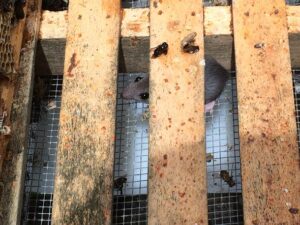Hello Beekeepers!
I use this blog to update folks with some timely considerations, if you have a new colony in a climate comparable to SW Michigan’s. These considerations may / not apply to you, depending upon your apiary management approach, colony progress, etc. But, there’s plenty to learn in beekeeping, and I hope this is one of the sources you turn to for insights.
Earwigs: There are unfortunately plenty of them, due to the continued dampness. If you have “only” several dozen, they probably don’t bother the bees much. If things would dry up, that problem should diminish. I wouldn’t add more space to the colony though until you’re sure they’re ready for it. A strong colony will keep the populations of all sorts of undesired critters under control.
Chalkbrood: This is a fungal issue exacerbated by moisture. I’ve had a couple of you contact me with pics and descriptions that fit. If you’re seeing white “bread mold” in the hive, and / or yellow or black larva, this might be your issue. Google “chalkbrood in bees” for a wealth of information. And good luck!
Sampling for Varroa mites: A newbee asked me if they need to monitor their levels. My answer is comparable to the one my sister the dentist gives patients who ask if they need to floss their teeth. “Nope,” she says. “Just the ones you want to keep.”
And you only need to monitor for Varroa in the colonies you want to keep … and monitor at least monthly.
Google ‘sample for Varroa mite Bee Lab’ for the University of Minnesota’s excellent PDF on it. Sampling is easy and interesting and pretty weird (and amusing) when the bees come out all ghosted with powdered sugar.
Your mite count is probably acceptable now—colonies are still building up—but that will likely change. And if you’ve lost a queen or the colony requeened (which seems fairly rampant from folks I’ve been talking with) that has an up side. The break in the bee brood cycle is also a break in the Varroa mite cycle.
If your level gets to the “do something” point, there are a variety of things you can do. Unfortunately, there is no single, clear-cut answer, and all the options have pros and cons and conflicting data on effectiveness.
Attacking Varroa mites: We are starting to routinely sprinkle powdered sugar across the top bars weekly, one cup per box when we’re in there. Historically I’ve had great success using it and drone comb foundation.
Mama mites prefer to lay in drone cells as drones take longer to develop. If you use drone comb, when it is fairly full of capped drones, be sure to remove it before those drones (and any mites) hatch … or you’ve just created a mite factory! You then freeze it for at least 48 hours and then put it back in a hive for them to eat the now-dead drones (for protein). My guests searching for ice cream are always curious about it when they find it in the freezer (I offer them dead drone mini-popsicles). Of course, this year, our bees are putting honey in the drone comb, sigh. Bees are gonna do what bees are gonna do.
Finding the queen: No, you don’t need to find her every time you’re in the hive, but you should make sure to find evidence of her, like eggs (means you’ve had a queen within the last three days) or larva (eight days). If you see eggs, and their behavior isn’t particularly cranky (absent other stressors like storms), you’re likely fine. If you only see larva and no eggs (and no queen) check again in a few days. Seems to be a lot of requeening by bees going on …
Love your questions. Email, call or FB me. And watch out for frogs, mice and Varroa!

